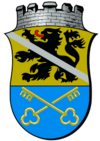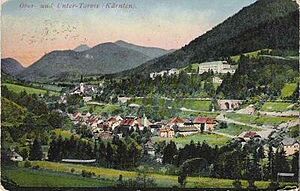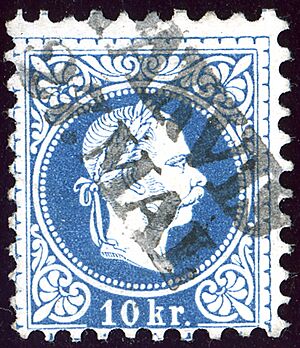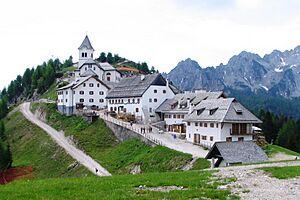Tarvisio facts for kids
Quick facts for kids
Tarvisio
|
||
|---|---|---|
| Città di Tarvisio | ||
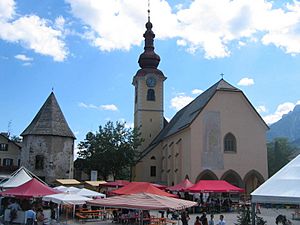
Main square with Sts. Peter and Paul Church
|
||
|
||
| Country | Italy | |
| Region | Friuli-Venezia Giulia | |
| Province | Udine (UD) | |
| Frazioni | Tarvisio Centrale, Camporosso in Valcanale, Cave del Predil, Coccau, Fusine in Valromana, Monte Lussari, Muda, Plezzut, Poscolle, Rutte, Sant'Antonio | |
| Area | ||
| • Total | 205 km2 (79 sq mi) | |
| Elevation | 754 m (2,474 ft) | |
| Population
(2007)
|
||
| • Total | 4,962 | |
| • Density | 24.20/km2 (62.69/sq mi) | |
| Demonym(s) | Tarvisiani | |
| Time zone | UTC+1 (CET) | |
| • Summer (DST) | UTC+2 (CEST) | |
| Postal code |
33018
|
|
| Dialing code | 0428 | |
| Patron saint | Saint Peter and Saint Paul | |
| Saint day | June 29 | |
Tarvisio is a charming town, or comune, located in the Friuli-Venezia Giulia region of Italy. It's a special place because it sits right at the border where three countries meet: Italy, Austria, and Slovenia. This means people here speak different languages, including Italian, German, and Slovenian.
Tarvisio is known for its beautiful mountain scenery and its history as a trade route. It's a popular spot for both summer and winter activities.
Contents
Exploring Tarvisio's Location
Tarvisio is nestled in a valley called the Canal Valley (Val Canale). This valley is surrounded by impressive mountain ranges. To the north, you'll find the Carnic Alps and Karawanks. To the south are the Julian Alps.
Because of its unique location, Tarvisio is part of a special "tripoint." This is where the areas where Romance, Germanic, and Slavic languages are spoken all come together.
A small hill west of the town marks an important natural divide. Water flowing from one side goes into the Danube River basin. Water from the other side flows into the Adriatic Sea.
How to Get to Tarvisio
Tarvisio is easy to reach by road. The A23 Alpe-Adria highway passes right by the town. This highway connects Austria to other parts of Italy.
There's also a modern railway station in Tarvisio. It's part of a new train line that opened in 2000. This line makes it easy to travel between Villach in Austria and Udine in Italy.
Tarvisio's Climate
Tarvisio has a continental climate, which means it has distinct seasons. Winters can be quite cold, with temperatures sometimes dropping very low. For example, the coldest temperature ever recorded was -23 degrees Celsius in January 1985.
Summers, on the other hand, can be very warm. The highest temperature ever recorded was 37 degrees Celsius in July 1983.
| Climate data for Tarvisio (1991–2020, extremes 1953–present) | |||||||||||||
|---|---|---|---|---|---|---|---|---|---|---|---|---|---|
| Month | Jan | Feb | Mar | Apr | May | Jun | Jul | Aug | Sep | Oct | Nov | Dec | Year |
| Record high °C (°F) | 13.6 (56.5) |
18.4 (65.1) |
22.7 (72.9) |
25.8 (78.4) |
30.2 (86.4) |
34.0 (93.2) |
37.2 (99.0) |
35.2 (95.4) |
29.8 (85.6) |
25.2 (77.4) |
21.0 (69.8) |
14.4 (57.9) |
37.2 (99.0) |
| Mean daily maximum °C (°F) | 2.4 (36.3) |
4.5 (40.1) |
9.1 (48.4) |
13.6 (56.5) |
18.4 (65.1) |
22.4 (72.3) |
24.5 (76.1) |
24.2 (75.6) |
19.2 (66.6) |
13.7 (56.7) |
7.1 (44.8) |
2.4 (36.3) |
13.5 (56.3) |
| Daily mean °C (°F) | −1.0 (30.2) |
0.4 (32.7) |
4.2 (39.6) |
8.3 (46.9) |
12.9 (55.2) |
16.7 (62.1) |
18.3 (64.9) |
18.3 (64.9) |
13.9 (57.0) |
9.4 (48.9) |
4.1 (39.4) |
−0.6 (30.9) |
8.7 (47.7) |
| Mean daily minimum °C (°F) | −4.3 (24.3) |
−3.7 (25.3) |
−0.5 (31.1) |
3.1 (37.6) |
7.4 (45.3) |
10.9 (51.6) |
12.3 (54.1) |
12.4 (54.3) |
8.7 (47.7) |
5.1 (41.2) |
1.2 (34.2) |
−3.6 (25.5) |
4.1 (39.4) |
| Record low °C (°F) | −23.2 (−9.8) |
−22.4 (−8.3) |
−20.5 (−4.9) |
−10.8 (12.6) |
−6.2 (20.8) |
−1.2 (29.8) |
2.4 (36.3) |
1.8 (35.2) |
−2.6 (27.3) |
−7.1 (19.2) |
−15.4 (4.3) |
−18.9 (−2.0) |
−23.2 (−9.8) |
| Average precipitation mm (inches) | 53.7 (2.11) |
61.5 (2.42) |
68.8 (2.71) |
89.5 (3.52) |
110.3 (4.34) |
120.7 (4.75) |
137.3 (5.41) |
145.7 (5.74) |
144.0 (5.67) |
153.8 (6.06) |
143.7 (5.66) |
87.8 (3.46) |
1,316.7 (51.84) |
| Average precipitation days (≥ 1.0 mm) | 4.5 | 5.4 | 5.9 | 8.8 | 11.2 | 10.8 | 10.3 | 11.0 | 9.0 | 8.4 | 8.7 | 6.6 | 100.5 |
| Average relative humidity (%) | 81.3 | 76.2 | 72.8 | 72.3 | 72.7 | 73.2 | 73.1 | 74.6 | 77.4 | 80.4 | 83.9 | 84.2 | 76.8 |
| Average dew point °C (°F) | −3.5 (25.7) |
−3.3 (26.1) |
−0.5 (31.1) |
3.1 (37.6) |
7.9 (46.2) |
12.0 (53.6) |
13.6 (56.5) |
14.1 (57.4) |
10.6 (51.1) |
6.7 (44.1) |
1.9 (35.4) |
−2.4 (27.7) |
5.0 (41.0) |
| Source 1: NOAA | |||||||||||||
| Source 2: Servizio Meteorologico | |||||||||||||
Languages Spoken in Tarvisio
Tarvisio has a rich history of different languages. For a long time, until 1918, it was part of the Austrian Empire. During that time, most people spoke German and Slovenian.
Today, Italian is the main language. However, there are still small groups of people who speak German and Slovenian. You might also hear Friulian, which is a local language of the region.
To celebrate its diverse heritage, the town's mayor put up signs in four languages. These signs show that the people of Tarvisio value using their different mother tongues.
Villages and Communities
The municipality of Tarvisio includes several smaller villages and communities. These are often called frazioni. Each one has its own unique character.
Here are some of the communities, with their names in Italian, German, Slovenian, and Friulian:
- Camporosso (Saifnitz, Žabnice, Cjamparos)
- Cave del Predil (Raibl, Rabelj, Rabil/Predil)
- Coccau (Goggau, Kokova, Cocau)
- Fusine in Valromana (Weißenfels/Weissenfels, Fužine/Bela Peč, Fusinis)
- Monte Lussari (Luschariberg, Svete Višarje, Mont Sante di Lussari)
- Muda (Mauth, Muta, Mude)
- Plezzut (Flitschl, Flíčl, Pleçùt)
- Poscolle (Hinterschloss, Zágradec, Puscuèl)
- Rutte (Greuth, Trbiške rute, Rute)
- Sant'Antonio (Sankt Anton, Sveti Anton, Sant Antòni)
- Riofreddo (Kaltwasser, Mrzla Voda)
A Look at Tarvisio's History
Tarvisio has a long history, dating back to Roman times. It was an important stop on ancient trade routes that crossed the Alps to Venice.
In the year 1007, a powerful ruler named Emperor Henry II gave control of the Canal Valley to the Diocese of Bamberg. This area was very important because of its nearby ore mines and ironworks.
Tarvisio remained under the control of the Prince-Bishopric of Bamberg for many centuries. Then, in 1758, the bishop sold Tarvisio to Empress Maria Theresa of Austria from the Habsburg family.
Until 1918, Tarvisio was part of the Duchy of Carinthia in Austria. It officially became a town in 1909. After World War I, in 1919, Tarvisio became part of Italy.
What to See in Tarvisio
Tarvisio offers many interesting places to visit and beautiful natural sights.
- Saints Peter and Paul Church: This historic church was built in the 15th century. It's a beautiful example of old architecture.
- Fusine Lakes: These stunning mountain lakes are a must-see. They are known for their clear waters and amazing reflections of the surrounding peaks.
- Mount Lussari: At the top of Mount Lussari, which is 1789 meters (5,869 feet) high, there's a special pilgrimage church. Legend says that in 1360, a shepherd found a statue of Virgin Mary here. You can reach the church and a nearby ski center by cable car.
- Ski Resorts: The area around the Sella Nevea mountain pass is a very popular place for skiing and snowboarding. Tarvisio gets a lot of snow, which makes it perfect for winter sports.
Tarvisio's Economy and Tourism
For many years, Tarvisio was a popular shopping destination. People from Austria and Yugoslavia would come to visit its famous "Rag Market." This market was known for its wide variety of goods.
Today, tourism and winter sports are very important for Tarvisio's economy. The beautiful mountains of the Karawanks, the Carnic Alps, and the Julian Alps attract many visitors.
Tarvisio is especially famous for its heavy alpine snow. This makes it a top spot for skiing and snowboarding. Many school groups come here to enjoy the slopes. The town has even hosted big international winter sports events, like the 2003 Winter Universiade and the Women's 2007 Alpine Skiing World Cup.
Famous People from Tarvisio
Here are some notable people who were born or lived in Tarvisio:
- Lambert Ehrlich (1878–1942), a Slovenian Roman Catholic priest, political figure, and ethnologist.
- Nives Meroi, an Italian mountaineer who has climbed all fourteen of the world's highest peaks (those over eight thousand meters).
Images for kids
See also
 In Spanish: Tarvisio para niños
In Spanish: Tarvisio para niños


